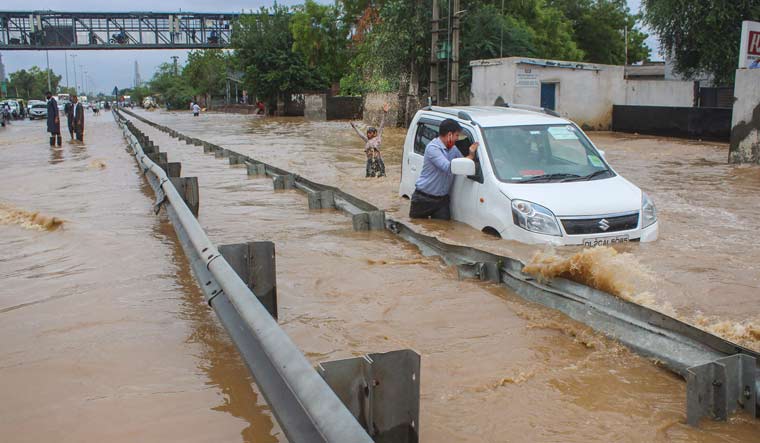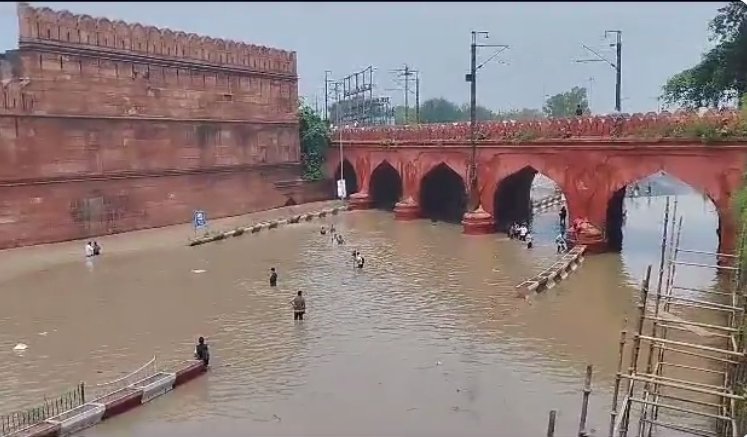
Will Delhi govt learn its lessons from an unprecedented deluge?

The torrential rains have once again brought the national capital to a standstill. Though the intensity of the rainfall has decreased considerably since July 8 and 9, when the city received over 150 mm of rainfall, life in Delhi continues to be affected with the Yamuna well above its danger mark of 205 metres.
This is not the first time that waterlogged stretches in the national capital have hit the headlines. Videos and images of waterlogged streets in Delhi showed areas like the Supreme Court, Rajghat, ITO, and the Red Fort, among others, bearing the brunt of the deluge as the Yamuna water level breached its danger mark smashing the all-time record set 45 years ago.
Also read: Delhi floods: Farmlands, shanties, shops inundated, evacuated people stare at bleak future
Meanwhile, Delhi Chief Minister Arvind Kejriwal directed Chief Secretary Naresh Kumar to seek help from the National Disaster Response Force (NDRF) and the Army to prevent the entry of floodwaters to new areas in Delhi.
As the city gears up to host the G20 Summit in September, urban planners and citizens have expressed concern over the condition of civic infrastructure and how a superficial makeover does very little to address the civic problems plaguing the capital.
From early January, officials began revamping the infrastructure to give the much-needed makeover to the city and more than a dozen projects are near completion as August deadline approaches and foreign dignitaries start arriving for the summit.
Is water from Hathni Kund Barrage to blame?
As much as the Delhi government would want us to believe that the barrage is primarily responsible for the floods in Delhi, a closer examination of the factors tell a different story.
Residents say that it would be incorrect to blame the overflowing Yamuna and excess water flow from the Hathni Kund Barrage for waterlogging in the city. They attribute the condition in the national capital to administrative apathy as the civic bodies did not act on time to remove silt from the choked drains.

The Hathni Kund Barrage is located on the Yamuna river in Haryana’s Yamuna Nagar district. As per the Central Water Commission, this year the water released from the barrage took less time to reach Delhi. Its velocity was high probably because of the encroachment of the floodplain, leaving a constricted route for the water to pass.
Also read: Water released to Haryana from Himachal has reduced, will impact Yamuna level: Kejriwal
As the AAP and the BJP spar over the release of water from Hathni Kund barrage, scientists and officials from Haryana government point out that the barrage is not a storage dam but a diversion structure. No storage is possible at the barrage and whatever inflows come in the Yamuna is bound to reach Delhi.
Drainage plan not in sync with changing demography
The national capital does not have a drainage master plan that corresponds to the city’s growing population. A fact that was raised by former professor Dr Amitabh Kundu, senior fellow with the World Resources Institute.
In 2011, the Delhi government tasked the Indian Institute of Technology (IIT) Delhi to come up with a drainage master plan for the city’s watershed and drainage system.
A river never forgets! Even after decades and centuries pass, the river would come back to recapture its borders. Yamuna reclaims it's floodplain. #Yamuna #DelhiFloods pic.twitter.com/VGjkvcW3yg
— Harsh Vats (@HarshVatsa7) July 13, 2023
However, the plan IIT Delhi submitted in 2018 was shelved by the government’s expert committee in 2021 for not being in terms with the reality. The Delhi government then appointed Public Works Department (PWD) as the nodal agency for the implementation of the city’s “comprehensive” drainage master plan.
Responding to this, AAP’s national spokesperson Nishikant Mohapatra said that the AAP government is engaging stakeholders and have roped in global experts to design a plan that corresponds to the city’s changing demography.
Have the rains subsided in Delhi?
Speaking to The Federal, Kuldeep Srivastava, senior scientist, IMD, predicted that light to moderate rainfall is expected to continue in Delhi on Friday, while a ‘yellow’ alert has been issued for July 15. Moderate to heavy rainfall is predicted over Delhi on July 15. The unusual interaction of a western disturbance with the monsoon trough has caused heavy rainfall in the northern states. The Met office has predicted that the national capital will receive light to moderate rainfall from July 14 to July 19.
Also read: Yamuna swells further after breaching record level in Delhi; evacuations on
Key areas affected due to floods
The rise in water level in the Yamuna has caused flooding in several key parts of the national capital including ITO area, which is a critical route to commute from East Delhi to Central Delhi and Connaught Place. Waterlogging also continued near ISBT, Rajghat, Yamuna Bazar and Geeta Colony. The road outside Hanuman Mandir near Kashmiri Gate in Delhi is also heavily waterlogged.
Factors causing frequent flood-like incidents
Kundu has attributed two major factors that are contributing to the sudden increase in instances of flooding in Delhi.
These are uncontrolled urbanisation and encroachment upon natural drainage systems, which result in frequent flood-like situation in Delhi. Unchecked filling of urban water bodies has also become a widespread problem. The spurt in illegal colonies throughout the city, without adherence to proper planning measures, has resulted in the narrowing of natural drainage systems.
#NewDelhi forecast for next seven days.#WeatherUpdate #WeatherAlert #weatherforecast #Monsoon #monsoon2023 #DelhiRains @moesgoi@DDNewslive@airnewsalerts@ndmaindia pic.twitter.com/io5cbLv1fd
— India Meteorological Department (@Indiametdept) July 13, 2023
“Even though the population in Delhi has increased about four times from the 1970s, the current drainage master plan still follows the one drawn up in 1976 when the population was around 60 lakh,” observed Kundu.
Also read: Delhi floods: Govt offices, school, colleges to remain closed in Delhi till Sunday
How the Yamuna cuts across the city
River Yamuna runs a course of 22 kilometres through the north-south vertical of the city. There are 10 embankments along the river to save the national capital from devastating floods when Yamuna breaches its danger mark.
The Yamuna, Delhi’s lifeline, is crying for urgent attention as it has been reduced to a dumping ground for household and industrial wastes. It is also a victim of lopsided development. Despite allocation of close to Rs 7,000 crore for cleaning the Yamuna over four years (2017–2021), the report of the Delhi Pollution Control Committee suggests that most of its stretch along Delhi remained as polluted as ever, with its water not fit for bathing.
Water supply disrupted
Several parts of the city are witnessing a severe shortage in water supply. Three water treatment plants have been shut down as water has entered pumps and machines. Roughly 25 per cent of the water supply in Delhi is impacted due to the closure of the three treatment plants. “There can be water scarcity for a day or two. I hope that the supply resumes by Friday evening,” Arvind Kejriwal told the media while inspecting the Wazirabad Water Treatment Plant.


